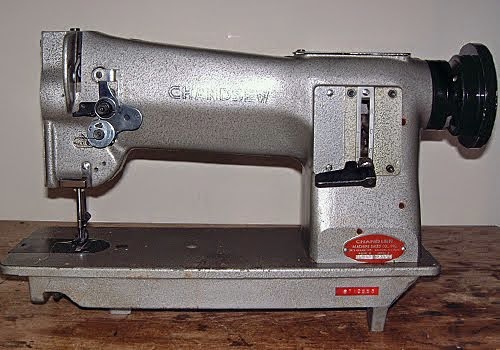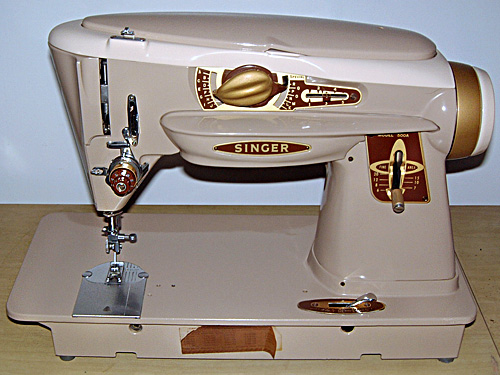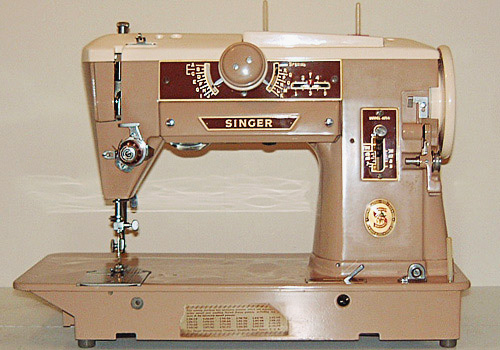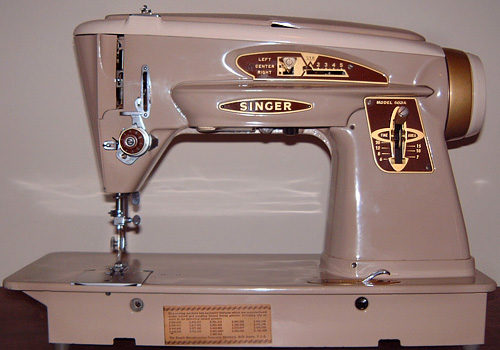It wasn't an especially busy week for sewing machines. I did take in a 306W for a general servicing. I hadn't seen one before, so it was nice to have one on the bench for a bit. And I picked up yet another 401A at a garage sale. I've continued with a number of postings on Craigslist of machines I have for sale. And I've been making an attempt at better arranging my shop/office for a better use of space.
The 401A is from 1951. As I've now had a few of these on my bench, I noticed features specific to the year. I don't know these machines well enough to know just what changes were made and when, but a couple of things stood out as I worked on this one: first of all, the top cam-hatch has a decal on it, while later years do not (again, just when these changes occur, I haven't, yet, a clue). I also noticed that the screws used to attach the various adjustment plates are "bright" finished as opposed to the color-matched screws from later years. Little things, but a matter of interest when one delves into these on a fairly frequent basis.
This latest acquisition also had me in mind of some of the tell-tales of a machine's condition and potential value. When evaluating that potential, it's always best to do so before buying, but I'm rather quick to buy and slow to evaluate when, say, hitting garage sales on any given Saturday. It's only after getting my latest find back home that I begin to note any real problems (or lack thereof).
A few clues as to how a machine (in this case Singers from the 400/500 series) may have been treated throughout its life include: the condition of the various screws used throughout. If they show few signs of screwdriver wear, that's certainly a good sign. It means the machine wasn't roughly handled, or in for much servicing.
I now look at the spool pins as well; are they noticeably bent? Straighter pins have seen fewer hours of use. Are they yellowed with age and exposure? I like to see whiter/clearer spool pins (these are the plastic pins).
Perhaps most importantly, for me, is the condition of the machine's interior. This is where one can usually determine something about the life a machine has had. Clean, dry surfaces without any signs of grease and oil are always something I like to see. This latest 401A seems to have never been in for service; clean, dry and unmarked.
Of course, the condition of the exterior is very important. And here, too, this one is near perfect. While a few scratches or chips are the norm, and don't have too great an impact on resale value, a machine with no discernible flaws warrants an escalating premium. Here is a machine worthy of special consideration.
You can image the satisfaction there is in freeing from years of dirt, grime and disuse, a marvelous machine in near like-new condition.
Buying, selling, servicing, using... thoroughly enjoying these marvels of mid-century domestic engineering.
Chandsew 406RB

Size Matters

Singer 153W103 Industrial

Singer 316G

Singer 301

A design revolution for Singer, this light-weight portable is a favorite with quilters. This example dates from 1951, but, interestingly, isn't badged as an anniversary model.
Singer 221- Featherweight

In remarkable condition. This one dates from 1956.
Singer 500A

Reassembled and polished.
Singer 401A

Singer 503A

I've had a number of examples from the 400 and 500 series pass through my hands now, and as testament to their quality, they have all been in very nice condition; none, however, has matched this beauty for its near pristine state of preservation. While even on the cleanest example one must forgive a minor imperfection or two, this classic from Singer exhibits none! Truly as nice as one could hope.
Monday, September 26, 2011
Monday, September 12, 2011
Revisiting Number One – 1951 Singer 128
This was the first sewing machine I ever worked on, and, as little was needed, it didn't present the challenge I could have used at the time. I gave it an oiling back then, and made sure the thing worked. And, yes, it worked... very well.
I didn't know a sewing machine could make such fine stitches. I had to look close to see the individual stitches. Of course, until then, I hadn't paid much attention to stitches of any sort.
And I was taken aback by the age of this machine. This look, that Singer is famous for, was synonymous for all things ancient to me. Well, antique, anyway. Put one of these next to a stagecoach and I'd have thought they belonged to each other.
But this machine dates from 1951; attested to by the extra adornment on its badge. It has the blue band signifying Singer's 100th anniversary. This is the same year that Singer introduced the 301 slant-shank machine, with its modern, mid-century flair. Here we had the stagecoach trying to out-race the streamlined locomotive.
Today, I looked more closely at the shuttle bobbin, and paid attention to how its parts went together and how they worked. I knew this time that one had to insert the bobbin with its thread wound one way and not the other.
Threading this machine is easy and straightforward, though its stitch-length knob was another something I had to figure out. But soon, it was working as well as ever. And still that beautifully fine stitch.
I didn't know a sewing machine could make such fine stitches. I had to look close to see the individual stitches. Of course, until then, I hadn't paid much attention to stitches of any sort.
And I was taken aback by the age of this machine. This look, that Singer is famous for, was synonymous for all things ancient to me. Well, antique, anyway. Put one of these next to a stagecoach and I'd have thought they belonged to each other.
But this machine dates from 1951; attested to by the extra adornment on its badge. It has the blue band signifying Singer's 100th anniversary. This is the same year that Singer introduced the 301 slant-shank machine, with its modern, mid-century flair. Here we had the stagecoach trying to out-race the streamlined locomotive.
Today, I looked more closely at the shuttle bobbin, and paid attention to how its parts went together and how they worked. I knew this time that one had to insert the bobbin with its thread wound one way and not the other.
Threading this machine is easy and straightforward, though its stitch-length knob was another something I had to figure out. But soon, it was working as well as ever. And still that beautifully fine stitch.
Saturday, September 10, 2011
A New Name. A New Purpose.
Same ol' look, but now with a new name to reflect new sensibilities. After having bought, serviced and sold a number of machines, I'm more confident in my take on vintage sewing machines and what they need to be kept in good repair. While no expert on any, and woefully ignorant of many, I've come to appreciate the way sewing machines work, how they're made, and what they need to be of use for another good many years.
I've now built up an inventory that far exceeds my wife, Mary's, need for machines for her crafting events. A few favorites have fallen from favor, and others have taken their places. I have duplicates of some, and others are perhaps a little too fussy to render good service to the beginner sewist. Others are more in the vein of the collectable, so not meant for the rigors of daily use, but are rather kept as great examples of what was being made in those last few years before the influx of foreign competitors and the advent of plastics.
So, this hobby has taken a turn. I can no longer justify the collecting of machines when there is little need and no room for them. Something has to give. And I did make an effort to stop the buying. But it wasn't long before I wanted another project. I just had to begin another. I do like bringing these little engines of domestic industry back to life. And I enjoy as much seeing them "re-homed" with others for whom they are bringers of pride and joy.
I turn then to servicing other people's sewing machines; to servicing yours if you have the need; have the machine I know well enough; have the means for dropping it off and picking it up; have the spirit to entrust it to a non-professional whose attempts at added value extend beyond the practical to the need to see some forgotten glory reborn.
Let's see what happens...
I've now built up an inventory that far exceeds my wife, Mary's, need for machines for her crafting events. A few favorites have fallen from favor, and others have taken their places. I have duplicates of some, and others are perhaps a little too fussy to render good service to the beginner sewist. Others are more in the vein of the collectable, so not meant for the rigors of daily use, but are rather kept as great examples of what was being made in those last few years before the influx of foreign competitors and the advent of plastics.
So, this hobby has taken a turn. I can no longer justify the collecting of machines when there is little need and no room for them. Something has to give. And I did make an effort to stop the buying. But it wasn't long before I wanted another project. I just had to begin another. I do like bringing these little engines of domestic industry back to life. And I enjoy as much seeing them "re-homed" with others for whom they are bringers of pride and joy.
I turn then to servicing other people's sewing machines; to servicing yours if you have the need; have the machine I know well enough; have the means for dropping it off and picking it up; have the spirit to entrust it to a non-professional whose attempts at added value extend beyond the practical to the need to see some forgotten glory reborn.
Let's see what happens...
Friday, September 9, 2011
A word about this collection...
I should mention that as this collection of mine is constantly evolving (revolving?), the photos I've been taking represent machines that are current to it. While one 401A looks much like any other, each deserves its moment in the spotlight, so what may appear to be duplicate photos, are in fact new images of new machines. I remove images of machines I've sold and add new images of new machines when I find the time to take them.
Today I'm posting photos of the machines that last spent time on my workbench: a 404, the 401A and that 503A. Each required a few hours of my attention, and all now show the the beauty that was hidden beneath years of accumulated dirt and grime. These now can be handled as one might a loved antique. Go ahead – rock that baby!
Today I'm posting photos of the machines that last spent time on my workbench: a 404, the 401A and that 503A. Each required a few hours of my attention, and all now show the the beauty that was hidden beneath years of accumulated dirt and grime. These now can be handled as one might a loved antique. Go ahead – rock that baby!
Wednesday, September 7, 2011
A Few New Machines – Singer Centric
I hadn't gone a day or two after the last machine left the bench, when I began to feel the need to get another. I took a little trip beyond the Greater San Francisco Bay Area – richer hunting ground. That day, anyway.
My newest finds are members a that class of Singers that I've come to like most: A 404, a 401A and a 503A, each with its own attributes and personality.
I tackled the 404 first and must say, this is a truly beautiful machine. It's had little use, and its condition is about as nice as I've seen. It's a simple machine, so, easy to reduce it to that point where I'll then begin building it back up to about as nice as it's likely to ever be again. It came with a nice case too. I hadn't seen one of these before and was surprised that the machine served as the bottom of the case. Very nicely designed. This keeps the machine light enough for it to be considered truly portable. In fact, this machine would have been the worthy successor to the 301A – itself heir apparent to the remarkable 221, the Featherweight.
Then a 401A. My favorite. All the bells and whistles in a no-nonsense, but still very attractive machine. This one, after giving it the treatment I give all my machines, looks great and should sew beautifully after an adjustment or two.
Finally a Vigorelli. Italian made. Very industrial looking. And green.
Pictured above you'll find a 503A stripped to the point where I begin its "treatment": hours of cleaning, some few minutes of oiling, and a final hand-rubbed polish.
Subscribe to:
Posts (Atom)